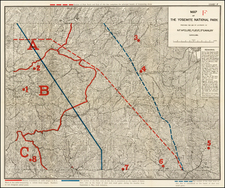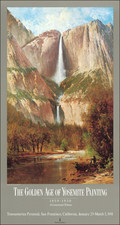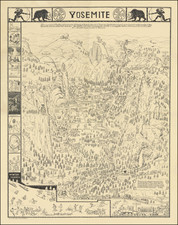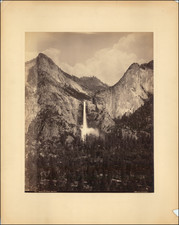Early Mammoth Plate Photograph by Carleton Watkins
View on the Merced River
"Carleton E. Watkins was a giant of photography. He is arguably America's greatest landscape photographer" - Palmquist & Kailbourn
An original mammoth-plate Yosemite photograph of the Merced by Carleton Watkins, the outstanding 19th century photographer of the American West. This image dates from Watkins's initial foray with the mammoth-plate camera in the Yosemite Valley.
In 1861 Watkins began making his famous large-scale "mammoth-plate" photographs in California's Yosemite Valley -- iconic views that are now unanimously accepted as some of the most beautiful photographic images ever made in the West. These images were influential in persuading the United States Congress to pass pioneering legislation to preserve the Yosemite Valley, which bill, the Yosemite Valley Grant Act, was signed into law by Abraham Lincoln on June 30, 1864. This law granted Yosemite Valley and the Mariposa Grove to the State of California, "to be held for public use, resort, and recreation...[the use of which in this manner] shall be inalienable for all time." Watkins was consulted by Yosemite Commissioner Frederick Law Olmsted on the best means to preserve Yosemite as a public trust. It wasn't until 1890, through the efforts of John Muir and others, that Yosemite was signed into existence as the nation's third National Park.
While the technical and aesthetic qualities of Watkins's Yosemite photographs were early lauded by enthusiasts and experts alike, including William H. Brewer of the California State Geological Survey ("the finest I have seen"), J. D. Whitney (who named a 8,500-foot peak in Yosemite after Watkins), Edward L. Wilson (editor of the Philadelphia Photographer, who noted that "[Watkins's] camera is mightier than the sword") and Oliver Wendell Holmes (the foremost photography critic of the time who said Watkins's photographs reached "a perfection of art which compares with the finest European work"), it wasn't until the 1970s when Watkins was re-discovered by the photographic art world that a brighter light was focused on his life and work. Watkins's mammoth-plate views of Yosemite are now solidly ensconced as part of the canon of fine art photography. Examples of Watkins's Yosemite photographs are in many great institutional collections, including the Bancroft Library, the Getty, the Metropolitan Museum of Art, the Huntington Library, and numerous other institutions.
The present photograph shows a view along the Merced River that Watkins photographed in 1861 during his initial photographic expedition in the Yosemite Valley, the first such tour with the mammoth-plate camera. The image conforms to a version dated 1861 by Weston Naef, though it is possible the example at hand was printed later, circa 1863. The photographer revisited this scene in 1865-1866, making another photograph from the same perspective, with some compositional changes. Watkins often returned to the same locations in Yosemite, making numerous photographs of the same subject over time.
Given that Watkins exposed multiple plates from his favored locations, the different lighting and atmospheric conditions of the moment would certainly result in a range of outcomes. One reason the water in the foreground appears stronger than El Capitan itself in the present print could be related to the manner in which water absorbs ultraviolet light, reducing the effects of atmospheric conditions such as haze or fog that may have been present at the moment when the plate was exposed.
Weston Naef has written on the subject of the present image:
This view was made looking southwest from the southwest corner of Leidig Meadow at the point where the Merced River changes direction from west to southwest. Boulders have fallen from Middle Brother; Cathedral Rock is at the right edge. This view is one of the set of thirty 1861 prints issued in 1863 [i.e. for the Yosemite Portfolio: Yo-Semite Valley, Photographic Views of the Falls and Valley of Yo-Semite in Mariposa County, California].
At some point Watkins began assigning his own catalogue numbers to his Yosemite photographs, with the present view conforming very closely (if not precisely) to CEW 41. Naef states that it is unknown when Watkins first began to assign numbers to his mammoth-plate negatives, but suggests that he might have numbered earlier views (such as the present 1861 image) outside of a strict chronology:
The numbering system for Yosemite provides a terminus post quem for commencement of the inventory since Watkins chose for the number one position a Yosemite picture made in 1865-66 (cat. no. 115) rather than one made in 1861.
Mammoth-Plate Camera.
Watkins made the negative for this image using his custom made oversized camera. This camera was constructed by a local San Francisco instrument maker to handle negatives as large as 18 x 22 inches (the so-called mammoth-plate format).
Watkins's most famous visit to Yosemite Valley took place in the summer of 1861, when the photographer brought with him for the first time a special camera designed to accommodate sheets of glass 45.7 x 55.9 cm (18 x 22 inches) in size that were popularly called "mammoth plates." Exactly how Watkins procured this highly unusual oversize camera is uncertain. One possibility is that it was fabricated by someone such as Thomas Tennant, who advertised his services in Hutchings's magazine as an instrument maker on Battery Street in San Francisco. - Naef & Hult-Lewis, page 45.
Watkins's Autograph
According to Weston Naef and Michael Hargraves, the style and character of Watkins' handwriting evolved over time. Specifically, the way he formed the W in his name changed from having pointed bottoms to having curved bottoms. This change, which happened sometime in 1861 (or possibly as late as 1863), was accompanied by additional modifications to his signature marked by spaces where he lifted the pen from the writing surface at mid stroke. Oddly enough, by 1872 Watkins had reverted to the pointed-bottom W.
An aid to dating the photograph at hand. Naef and Hargraves state there are few prints with Watkins's autograph signature between about 1865 and 1875. This is because he was too busy in the field, carting around his mammoth-plate camera up and down the Pacific Coast, to be able to sign many prints.
The present photograph bears an autograph signature that conforms in every detail to Watkins's pre-1872 autograph, i.e. it has a curved-bottom W, with instances where he has lifted the pen from the writing surface causing a space interruption in the line. The signature here matches one described in Naef's catalogue as having been made by Watkins ca. 1865-1866, and, given the unlikelihood of a 1865-1875 signed print, evidence points to 1865-1866 as the date of the present print.
Rarity
Original signed mammoth plate Yosemite prints by Watkins from this early period (ca. 1861) are rare in the market.
Versions of this image are held in important photographic collections, including: the Bancroft Library, Cooper-Hewitt, California Historical Society, Denver Art Museum, George Eastman House, Huntington Library, Metropolitan Museum of Art, Oakland Museum of Art, the Yosemite Museum, and others.
Carleton Watkins (American, 1829-1916) was one of the most highly acclaimed of early western photographers, yet Watkins's work has never been fully cataloged. No complete listings of his "Old Series" stereoviews, published before 1875, are known.
Watkins extensively photographed early San Francisco, Yosemite, Mendocino and the Sierra Nevada mining regions. His photogaphs of Yosemite helped influence Congress and President Lincoln in the preservation of Yosemite Valley. Watkins also made some of the earliest photographs of Southern California and the Pacific Nortwest. Watkins' Pacific Railroad series documents construction of the trans-continental railroad from Sacramento to Utah.














![A Hysterical Map Of Yosemite National Park Shown Through the Courtesy of Mother Nature Productions [with envelope]](https://storage.googleapis.com/raremaps/img/small/96648.jpg)

